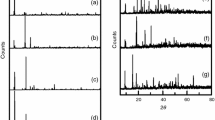Abstract
The characterisation of the ionic compound of lithium chloride, LiCl, through XRD, SEM, DSC, TG, DTG and TG-MS analysis is reported. The results show that nominally anhydrous LiCl particles can readily absorb water from the ambient atmosphere to form a surface layer of lithium chloride mono-hydrate, LiCl·H2O. Solid surface-hydrated LiCl is de-dehydrated via a two-stage mechanism at low heating rates and via a single-stage mechanism at high heating rates. Molten LiCl exhibits substantial evaporation at temperatures below its nominal boiling point, with the rate of evaporation increasing significantly before complete evaporation occurs. The melting process of de-hydrated LiCl is marginally affected by the heating rate; whilst the evaporation process is strongly affected by the heating rate and also dependent on the quantity of material used and the flow rate of the gas passed over it. Heating of surface-hydrated LiCl up to the point of evaporation under a flow of argon and under a flow of ambient air gives identical results, proposing the possibility of performing LiCl-based processes in an air environment. The enthalpies and activation energies for the processes of surface de-hydration, melting, and high-temperature evaporation are determined. The results are consistent with the following thermal phase evolution:













Similar content being viewed by others
References
Ebensperger A, Maxwell P, Moscoso C. The lithium industry: its recent evolution and future prospects. Resour Policy. 2005;30:218–31.
Karell EJ, Gourishankar KV, Smith JL, Chow LS, Redey L. Separation of actinides from LWR spent fuel using molten-salt-based electrochemical processes. Nucl Technol. 2001;136:342–53.
Hur JM, Seo CS, Hong SS, Kang DS, Park SW. Metallization of U3O8 via catalytic electrochemical reduction with Li2O in LiCl molten salt. React Kinet Catal Lett. 2003;80:217–22.
Iizuka M, Inoue T, Ougier M, Glatz JP. Electrochemical reduction of (U, Pu)O2 in molten LiCl and CaCl2 electrolytes. J Nucl Sci Technol. 2007;44:801–13.
Masset P, Guidotti RA. Thermally activated (“thermal”) battery technology. Part I: An overview. J Power Sources. 2006;161:1443–9.
Masset P, Guidotti RA. Thermal activated (thermal) battery technology. Part II. Molten salt electrolytes. J Power Sources. 2007;164:397–414.
Winter M, Besenhard JO, Spahr ME, Novák P. Insertion electrode materials for rechargeable lithium batteries. Adv Mater. 1998;10:725–63.
Sivakkumar SR, Nerkar JY, Pandolfo AG. Rate capability of graphite materials as negative electrodes in lithium-ion capacitors. Electrochim Acta. 2010;55:3330–5.
Xu Q, Schwandt C, Chen GZ, Fray DJ. Electrochemical investigation of lithium intercalation into graphite from molten lithium chloride. J Electroanal Chem. 2002;530:16–22.
Xu Q, Schwandt C, Fray DJ. Electrochemical investigation of lithium and tin reduction at a graphite cathode in molten chlorides. J Electroanal Chem. 2004;562:15–21.
Sychev J, Borisenko NV, Kaptay G, Kushkhov KB. Intercalation of sodium and lithium into graphite as a first stage in an electrochemical method for producing carbon nanotubes. Russ J Electrochem. 2005;41:956–63.
Sytchev J, Kaptay G. Influence of current density on the erosion of a graphite cathode and electrolytic formation of carbon nanotubes in molten NaCl and LiCl. Electrochim Acta. 2009;54:6725–31.
Chen GZ, Fan XD, Luget A, Shaffer MSP, Fray DJ, Windle AH. Electrolytic conversion of graphite to carbon nanotubes in fused salts. J Electroanal Chem. 1998;446:1–6.
Dimitrov AT, Chen GZ, Kinloch IA, Fray DJ. A feasibility study of scaling-up the electrolytic production of carbon nanotubes in molten salts. Electrochim Acta. 2002;48:91–102.
Schwandt C, Dimitrov AT, Fray DJ. The preparation of nano-structured carbon materials by electrolysis of molten lithium chloride at graphite electrodes. J Electroanal Chem. 2010;647:150–8.
Conde MR. Properties of aqueous solutions of lithium and calcium chlorides: formulations for use in air conditioning equipment design. Int J Therm Sci. 2004;43:367–82.
Monnin C, Dubois M, Papaiconomou N, Simonin JP. Thermodynamics of the LiCl + H2O system. J Chem Eng Data. 2002;47:1331–6.
Masset PJ. Thermogravimetric study of the dehydration reaction of LiCl·H2O. J Therm Anal Calorim. 2009;96:439–41.
Kissinger HE. Variation of peak temperature with heating rate in differential thermal analysis. J Res Nat Bur Stand. 1956;57:217–21.
Kissinger HE. Reaction kinetic in differential thermal analysis. Anal Chem. 1957;29:1702–6.
Boonchom B, Danvirutai C. Rapid synthesis, kinetics and thermodynamics of binary Mn0.5Ca0.5(H2PO4)2·H2O. J Therm Anal Calorim. 2009;98:717–23.
Danvirutai C, Noisong P, Youngme S. Some thermodynamic functions and kinetics of thermal decomposition of NH4MnPO4·H2O in nitrogen atmosphere. J Therm Anal Calorim. 2010;100:117–24.
Roine A. Outokumpu HSC chemistry for windows-chemical reaction and equilibrium software with extensive thermochemical database: Version 5.0. Outkumpu Research Oy Information Service. Finland; 2002.
Kubaschewski O, Alcock CB, Spencer PJ. Materials thermochemistry. 6th ed. Oxford: Pergamon Press; 1993.
Nitsch K, Dušek M, Nikl M, Polák K, Rodová M. Ternary alkali lead chlorides: crystal growth, crystal structure, absorption and emission properties. Prog Cryst Growth Charact. 1995;30:1–22.
Smirnov MV, Korzun IV, Oleynikova VA. Hydrolysis of molten alkali chlorides, bromides and iodides. Electrochim Acta. 1988;33:781–8.
Hur JM, Park SB, Seo CS, Jung KJ, Park SW. Melting and vaporization of salts in a U-LiCl-Li2O system. J Radioanal Nucl Chem. 2006;270:489–93.
Acknowledgements
The authors would like to thank R. Cornell and S.J. Griggs from the Department of Materials Science and Metallurgy, University of Cambridge, for their kind technical assistance.
Author information
Authors and Affiliations
Corresponding author
Rights and permissions
About this article
Cite this article
Kamali, A.R., Fray, D.J. & Schwandt, C. Thermokinetic characteristics of lithium chloride. J Therm Anal Calorim 104, 619–626 (2011). https://doi.org/10.1007/s10973-010-1045-9
Received:
Accepted:
Published:
Issue Date:
DOI: https://doi.org/10.1007/s10973-010-1045-9




